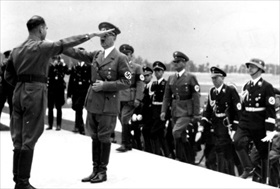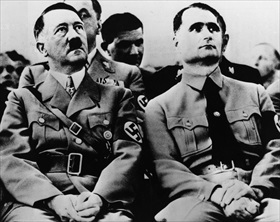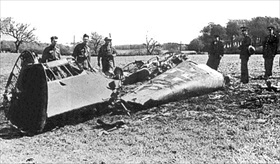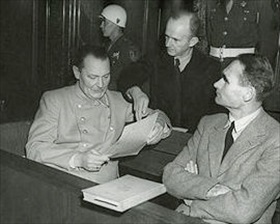HITLER FIXES LAUNCH DATE FOR BARBAROSSA
Berlin, Germany • May 12, 1941
On this date in 1941, two days after Deputy Reich Fuehrer Rudolf Hess had embarked on his historic “peace mission” to England (see story below), Adolf Hitler finally confirmed June 22 as the start date for Operation Barbarossa (Unternehmen Barbarossa), the German invasion of the Soviet Union. Moving toward the frontier of Soviet-occupied Poland were 3.6 million soldiers, 2,000 Luftwaffe pilots, 3,350 tank commanders, supported by 7,200 pieces of artillery, ready to do Hitler’s bidding. Among the Fuehrer’s goals was the eradication of the “Jewish Bolshevik” regime along with its supposed underpinnings (i.e., the Jewish “race”), combined with the aim of gaining a huge area for living space (“Lebensraum”) in the East suitable for German (“Aryan”) colonization and for exploiting new sources of foodstuffs and strategic natural resources to sustain the war. (By mid-1940 the Soviet Union had become Germany’s most important trading partner.)
Germany’s unannounced act of war against the Soviet Union, which Italian dictator Benito Mussolini and Hitler’s Axis military partner had read before it was announced publicly and with which he was in complete agreement, was full of typically delusional Hitlerian rhetoric: it stated that Nazi-holdout England had already lost the war; like a drowning man fumbling for a branch to save himself, British “warmongers” sought to save themselves by entering into some sort of military alliance with the Soviet Union. Defeating the Red Army in eight weeks would make Germany the unrivaled dominant power in Europe, dash British hopes for sustaining their war against Nazi Germany (England was an enemy Hitler did not want in the first place), and cause the hitherto neutral United States to think twice before entering the conflict on England’s side.
Hitler thanked Il Duce (Italian, “the leader”) for his offer to dispatch an Italian expeditionary corps to Germany’s Eastern Front but saw no urgent need for additional men and arms. The Wehrmacht (German armed forces) had enjoyed success from Day 1 in rolling up one Soviet formation after another, so much so that the Soviet western borderlands were turning into a ribbon-long graveyard for Soviet combatants and noncombatants, armored vehicles and artillery, and aircraft. In just 18 days, relentless German pressure had cost the Soviets over 3 million men, 6,000 tanks, and most of their air force. Battle-weary Red Army survivors, ill-trained, poorly led, many equipped with outmoded weapons, wandered around aimlessly. Inexperienced volunteer defenders were mowed down. A month later Mussolini, impatient to move off the sidelines and join Hitler in the war against their common enemy, dispatched aircraft, cars, trucks, horses, and 62,000 men, the first of over 200,000 Italian servicemen to fight the Soviets. By the time war-weary Italians deposed Mussolini on July 25, 1943, 64,000 of their countrymen had been killed or wounded on the Eastern Front and another 54,000 would die in enemy captivity. Worse yet, perhaps, was Hitler’s reaction to Italy’s announcement of an armistice with the Western powers on September 8–9 that year: 600,000 Italian soldiers, humiliated and disorganized in defeat and without orders, offered little resistance when a vengeful Wehrmacht gathered them up and delivered them as slave laborers to the German Reich later in month.
Rudolf Hess, Deputy Fuehrer to Adolf Hitler and Deputy Head of the Nazi Party, April 1933–May 1941
 |  |
Left: After hearing Adolf Hitler speak in a small Munich beer hall, Hess joined the fledgling Nazi Party on July 1, 1920, becoming the sixteenth member. After his first meeting with Hitler, Hess said he felt “as though overcome by a vision.” As a reward for his slavish submission Hitler granted Hess titles such as Reich Minister without Portfolio, member of the Secret Cabinet Council, member of the Ministerial Council for Reich Defense, and, three months after taking national power in January 1933, Deputy Fuehrer (Stellvertreter des Fuehrers), with responsibilities confined to Nazi Party matters, not those of the state. In 1939 Hess was even designated Hitler’s successor after Reich Marshal Hermann Goering.
![]()
Right: Once among Hitler’s constant and closest companions until 1933 (Hitler was best man at the Hess wedding and the two men conversed using the intimate pronoun “du”), by the mid-1930s Hess was becoming estranged from the Nazi center of power, viewed by many in Hitler’s inner sanctum (including Hitler and Goering) not only as an eccentric loner with obscure interests but a person who lacked the cunning and intelligence required to be a force within the ruthless Third Reich pecking order. (Hitler mocked his deputy for his fixation with the occult, astrology, and telepathy; Goering thought Hess “mad.”) Hoping to regain importance and redeem himself in the eyes of his beloved Fuehrer, Hess, who had been a pilot in World War I, flew solo in an unarmed German twin-engine Messerschmitt Bf-110 fighter from Augsburg, Bavaria, to Scotland on a bizarre, one-man “peace mission” on May 10, 1941, just weeks before Operation Barbarossa, the Nazi invasion of the Soviet Union. Under British interrogation Hess proposed that if the British would allow Germany to dominate Europe, then the British Empire would be spared further molestation by Hitler.
 |  |
Left: Desperate flight of fancy: the wreckage of Hess’s Messerschmitt Bf 110 after the self-chosen peace emissary parachuted into Scotland on May 10, 1941, and was taken prisoner, first by a pitchfork-wielding local farmer who took him to his farmhouse, then by the authorities. When Hitler met Mussolini in early June 1941, he teared up, confessing he had a “Hess problem.” Hitler and the Nazi propaganda mill went into a full court press, describing Hess as mentally ill. (British psychiatrists who treated Hess during his incarceration in England concluded that their patient was mentally unstable but not insane, an opinion shared by British Prime Minister Winston Churchill, who dismissed Hess as “a disordered mind” and derided his naïve “peace mission.”) One theory explaining the Nazis’ full court press is that Hitler was worried lest his deputy spill the beans to the British about his impending liquidation of the Soviet Union, so the Nazis made every attempt to trash Hess’s image inside and outside Germany.
![]()
Right: Defendants former Reich Marshal Hermann Goering, former Kriegsmarine chief Adm. Karl Doenitz (dark suit), and former Deputy Fuehrer Rudolf Hess confer during the Nuremberg Trials, 1945–1946. During the trial and his imprisonment, Hess seemed uninterested in the proceedings, rarely talked but when he did he rambled, was mostly avoided by his fellow prisoners, and showed signs of amnesia and mental illness. Hitler’s Deputy Fuehrer was found guilty of crimes against peace (planning and preparing a war of aggression) and conspiracy with other German leaders to commit crimes. He was handed a life sentence and incarcerated in Berlin’s Spandau Prison until his death, maybe by suicide, maybe not (conspiracy theories abound; see video), at age 93, in August 1987. He was Spandau’s last inmate.
Rudolf Hess: His Trial at Nuremberg and the Controversy Over His Death
![]()

 History buffs, there is good news! The Daily Chronicles of World War II is now available as an ebook for $4.99 on Amazon.com. Containing a year’s worth of dated entries from this website, the ebook brings the story of this tumultuous era to life in a compelling, authoritative, and succinct manner. Featuring inventive navigation aids, the ebook enables readers to instantly move forward or backward by month and date to different dated entries. Simple and elegant! Click
History buffs, there is good news! The Daily Chronicles of World War II is now available as an ebook for $4.99 on Amazon.com. Containing a year’s worth of dated entries from this website, the ebook brings the story of this tumultuous era to life in a compelling, authoritative, and succinct manner. Featuring inventive navigation aids, the ebook enables readers to instantly move forward or backward by month and date to different dated entries. Simple and elegant! Click 











